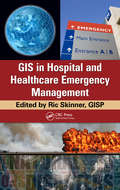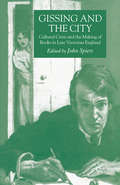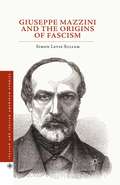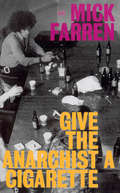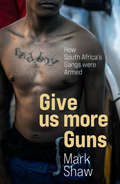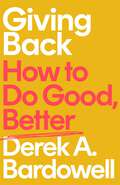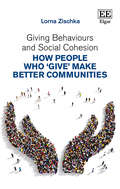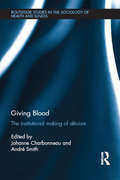- Table View
- List View
GIS and the Social Sciences: Theory and Applications
by Graham Clarke Dimitris Ballas Rachel S. Franklin Andy NewingGIS and the Social Sciences offers a uniquely social science approach on the theory and application of GIS with a range of modern examples. It explores how human geography can engage with a variety of important policy issues through linking together GIS and spatial analysis, and demonstrates the importance of applied GIS and spatial analysis for solving real-world problems in both the public and private sector. The book introduces basic theoretical material from a social science perspective and discusses how data are handled in GIS, what the standard commands within GIS packages are, and what they can offer in terms of spatial analysis. It covers the range of applications for which GIS has been primarily used in the social sciences, offering a global perspective of examples at a range of spatial scales. The book explores the use of GIS in crime, health, education, retail location, urban planning, transport, geodemographics, emergency planning and poverty/income inequalities. It is supplemented with practical activities and datasets that are linked to the content of each chapter and provided on an eResource page. The examples are written using ArcMap to show how the user can access data and put the theory in the textbook to applied use using proprietary GIS software. This book serves as a useful guide to a social science approach to GIS techniques and applications. It provides a range of modern applications of GIS with associated practicals to work through, and demonstrates how researcher and policy makers alike can use GIS to plan services more effectively. It will prove to be of great interest to geographers, as well as the broader social sciences, such as sociology, crime science, health, business and marketing.
GIS for Critical Infrastructure Protection
by Robert F. AustinGIS for Critical Infrastructure Protection highlights the GIS-based technologies that can be used to support critical infrastructure protection and emergency management. The book bridges the gap between theory and practice using real-world applications, real-world case studies, and the authors' real-world experience. Geared toward infrastructure ow
GIS for Environmental Applications: A practical approach
by Xuan ZhuGIS for Environmental Applications provides a practical introduction to the principles, methods, techniques and tools in GIS for spatial data management, analysis, modelling and visualisation, and their applications in environmental problem solving and decision making. It covers the fundamental concepts, principles and techniques in spatial data, spatial data management, spatial analysis and modelling, spatial visualisation, spatial interpolation, spatial statistics, and remote sensing data analysis, as well as demonstrates the typical environmental applications of GIS, including terrain analysis, hydrological modelling, land use analysis and modelling, ecological modelling, and ecosystem service valuation. Case studies are used in the text to contextualise these subjects in the real world, examples and detailed tutorials are provided in each chapter to show how the GIS techniques and tools introduced in the chapter can be implemented using ESRI ArcGIS (a popular GIS software system for environmental applications) and other third party extensions to ArcGIS to address.The emphasis is placed on how to apply or implement the concepts and techniques of GIS through illustrative examples with step-by-step instructions and numerous annotated screen shots. The features include: Over 350 figures and tables illustrating how to apply or implement the concepts and techniques of GIS Learning objectives along with the end-of-chapter review questions Authoritative references at the end of each chapter GIS data files for all examples as well as PowerPoint presentations for each chapter downloadable from the companion website. GIS for Environmental Applications weaves theory and practice together, assimilates the most current GIS knowledge and tools relevant to environmental research, management and planning, and provides step-by-step tutorials with practical applications. This volume will be an indispensable resource for any students taking a module on GIS for the environment.
GIS for Environmental Applications: A practical approach
by Xuan ZhuGIS for Environmental Applications provides a practical introduction to the principles, methods, techniques and tools in GIS for spatial data management, analysis, modelling and visualisation, and their applications in environmental problem solving and decision making. It covers the fundamental concepts, principles and techniques in spatial data, spatial data management, spatial analysis and modelling, spatial visualisation, spatial interpolation, spatial statistics, and remote sensing data analysis, as well as demonstrates the typical environmental applications of GIS, including terrain analysis, hydrological modelling, land use analysis and modelling, ecological modelling, and ecosystem service valuation. Case studies are used in the text to contextualise these subjects in the real world, examples and detailed tutorials are provided in each chapter to show how the GIS techniques and tools introduced in the chapter can be implemented using ESRI ArcGIS (a popular GIS software system for environmental applications) and other third party extensions to ArcGIS to address.The emphasis is placed on how to apply or implement the concepts and techniques of GIS through illustrative examples with step-by-step instructions and numerous annotated screen shots. The features include: Over 350 figures and tables illustrating how to apply or implement the concepts and techniques of GIS Learning objectives along with the end-of-chapter review questions Authoritative references at the end of each chapter GIS data files for all examples as well as PowerPoint presentations for each chapter downloadable from the companion website. GIS for Environmental Applications weaves theory and practice together, assimilates the most current GIS knowledge and tools relevant to environmental research, management and planning, and provides step-by-step tutorials with practical applications. This volume will be an indispensable resource for any students taking a module on GIS for the environment.
GIS in Hospital and Healthcare Emergency Management
by GISP, Ric SkinnerAlthough many books have been published on the application of GIS in emergency management and disaster response, this is the first one to bring together a comprehensive discussion of the critical role GIS plays in hospital and healthcare emergency management and disaster response. Illustrating a wide range of practical applications, GIS in Hospital
Gissing and the City: Cultural Crisis and the Making of Books in Late-Victorian England
by J. SpiersGissing and the City: Cultural Crisis and the Making of Books in Late Victorian England addresses the late Victorian cultural crisis and aesthetic revolt in urban life, politics, literature and art, by special reference to the experience of the shocks of the new urban environment, and literary and artistic responses. It does so through interdisciplinary discussion of the novels of George Gissing, whose work is particularly linked to 'the city' and the crisis of urban experience, especially in the archetypal modern imperial city.
The Gisu of Uganda: East Central Africa Part X
by J. S. La FontaineRoutledge is proud to be re-issuing this landmark series in association with the International African Institute. The series, originally published between 1950 and 1977, collected ethnographic information on the peoples of Africa, using all available sources: archives, memoirs and reports as well as anthropological research which, in 1945, had only just begun. Concise, critical and (for its time) accurate, the Ethnographic Survey contains sections as follows: Physical Environment Linguistic Data Demography History & Traditions of Origin Nomenclature Grouping Cultural Features: Religion, Witchcraft, Birth, Initiation, Burial Social & Political Organization: Kinship, Marriage, Inheritance, Slavery, Land Tenure, Warfare & Justice Economy & Trade Domestic Architecture Each of the 50 volumes will be available to buy individually, and these are organized into regional sub-groups: East Central Africa, North-Eastern Africa, Southern Africa, West Central Africa, Western Africa, and Central Africa Belgian Congo. The volumes are supplemented with maps, available to view on routledge.com or available as a pdf from the publishers.
The Gisu of Uganda: East Central Africa Part X
by J. S. La FontaineRoutledge is proud to be re-issuing this landmark series in association with the International African Institute. The series, originally published between 1950 and 1977, collected ethnographic information on the peoples of Africa, using all available sources: archives, memoirs and reports as well as anthropological research which, in 1945, had only just begun. Concise, critical and (for its time) accurate, the Ethnographic Survey contains sections as follows: Physical Environment Linguistic Data Demography History & Traditions of Origin Nomenclature Grouping Cultural Features: Religion, Witchcraft, Birth, Initiation, Burial Social & Political Organization: Kinship, Marriage, Inheritance, Slavery, Land Tenure, Warfare & Justice Economy & Trade Domestic Architecture Each of the 50 volumes will be available to buy individually, and these are organized into regional sub-groups: East Central Africa, North-Eastern Africa, Southern Africa, West Central Africa, Western Africa, and Central Africa Belgian Congo. The volumes are supplemented with maps, available to view on routledge.com or available as a pdf from the publishers.
Giuseppe Mazzini and the Origins of Fascism (Italian and Italian American Studies)
by Simon Levis SullamThis controversial and groundbreaking study proposes a compelling reinterpretation of the political thought of one Italy's founding fathers, Giuseppe Mazzini (1805-1872), and in the process suggests a new approach to understanding the origins of fascist ideology.
Give: Charity And The Art Of Living Generously
by Magnus Macfarlane-BarrowFrom the founder of Mary’s Meals and the Sunday Times bestselling author of The Shed That Fed a Million Children, Magnus Macfarlane-Barrow travels the world encountering startling acts of charity and the power of generosity.
Give The Anarchist A Cigarette
by Mick FarrenThrough a long and chequered career, Mick Farren has functioned as a writer, poet, rock star, recording artist, rabble-rouser, critic and commentator, and even won a protracted obscenity trial at the Old Bailey. After resisting the idea for a long time, he has finally written his own highly personal and insightful account of the British counterculture in the 1960s and '70s, from the perspective of one who was right there in the thick of it. With a continuing and unashamed commitment to the tradition of sex, drugs and rock 'n' roll, he recounts a rollercoaster odyssey - sometimes violent and often hilarious - from early beatnik adventures in Ladbroke Grove, through the flowering hippies to the snarl of punk. He gives a firsthand, insider's account of the chaos, disorder and raging excess of those two highly excessive decades. At the centre of the book is Farren's career in the underground, as the man on the door at the UFO club, driving spirit at IT and, of course, lead singer with the Social Deviants. He describes his encounters with the celebrated and the notorious, who range from Jimi Hendrix and Germaine Greer to Julie Burchill and Sid Vicious, and concludes that the pop history of bohemian culture does not neatly divide itself into easy decades, but continues to this day, perhaps in different guises, but frequently with the same goals and motivations.
Give and Take: Developmental Foreign Aid and the Pharmaceutical Industry in East Africa (Princeton Studies in Global and Comparative Sociology)
by Nitsan ChorevGive and Take looks at local drug manufacturing in Kenya, Tanzania, and Uganda, from the early 1980s to the present, to understand the impact of foreign aid on industrial development. While foreign aid has been attacked by critics as wasteful, counterproductive, or exploitative, Nitsan Chorev makes a clear case for the effectiveness of what she terms “developmental foreign aid.”Against the backdrop of Africa’s pursuit of economic self-sufficiency, the battle against AIDS and malaria, and bitter negotiations over affordable drugs, Chorev offers an important corrective to popular views on foreign aid and development. She shows that when foreign aid has provided markets, monitoring, and mentoring, it has supported the emergence and upgrading of local production. In instances where donors were willing to procure local drugs, they created new markets that gave local entrepreneurs an incentive to produce new types of drugs. In turn, when donors enforced exacting standards as a condition to access those markets, they gave these producers an incentive to improve quality standards. And where technical know-how was not readily available and donors provided mentoring, local producers received the guidance necessary for improving production processes.Without losing sight of domestic political-economic conditions, historical legacies, and foreign aid’s own internal contradictions, Give and Take presents groundbreaking insights into the conditions under which foreign aid can be effective.
Give and Take: Developmental Foreign Aid and the Pharmaceutical Industry in East Africa (Princeton Studies in Global and Comparative Sociology)
by Nitsan ChorevGive and Take looks at local drug manufacturing in Kenya, Tanzania, and Uganda, from the early 1980s to the present, to understand the impact of foreign aid on industrial development. While foreign aid has been attacked by critics as wasteful, counterproductive, or exploitative, Nitsan Chorev makes a clear case for the effectiveness of what she terms “developmental foreign aid.”Against the backdrop of Africa’s pursuit of economic self-sufficiency, the battle against AIDS and malaria, and bitter negotiations over affordable drugs, Chorev offers an important corrective to popular views on foreign aid and development. She shows that when foreign aid has provided markets, monitoring, and mentoring, it has supported the emergence and upgrading of local production. In instances where donors were willing to procure local drugs, they created new markets that gave local entrepreneurs an incentive to produce new types of drugs. In turn, when donors enforced exacting standards as a condition to access those markets, they gave these producers an incentive to improve quality standards. And where technical know-how was not readily available and donors provided mentoring, local producers received the guidance necessary for improving production processes.Without losing sight of domestic political-economic conditions, historical legacies, and foreign aid’s own internal contradictions, Give and Take presents groundbreaking insights into the conditions under which foreign aid can be effective.
Give Children the Vote: On Democratizing Democracy
by John WallThroughout history, the right to vote has been extended to landowning men, the poor, minorities, women, and young adults. In each case, the meaning of democracy itself has been transformed. The one major group still denied suffrage is the third of humanity who are under 18 years of age. However, children are becoming increasingly active in political movements for climate regulation, labor rights, gun control, transexual identity, and racial justice. And these have led to a growing global movement to eliminate minimum ages of enfranchisement. This book argues that it is time to give children the vote. Using political theory and drawing on childhood studies, it shows why suffrage cannot legitimately be limited according to age, as well as why truly universal voting is beneficial to all and can help save today's crumbling democratic norms. It carefully responds to a wide range of objections concerning competence, knowledge, adult rights, power relations, harms to children, and much more. And it develops a detailed childist theory of voting based on holding elected representatives maximally responsive to the people's different lived experiences. The book also introduces the concept of proxy-claim voting, wherein parents or guardians exercise proxy votes for non-competent persons, both child and adult, until whatever time those persons wish to claim or reclaim the exercise of their vote for themselves. Ultimately, the book maps out a new vision of democratic voting that, by equally empowering children, is at last genuinely democratic.
Give Children the Vote: On Democratizing Democracy
by John WallThroughout history, the right to vote has been extended to landowning men, the poor, minorities, women, and young adults. In each case, the meaning of democracy itself has been transformed. The one major group still denied suffrage is the third of humanity who are under 18 years of age. However, children are becoming increasingly active in political movements for climate regulation, labor rights, gun control, transexual identity, and racial justice. And these have led to a growing global movement to eliminate minimum ages of enfranchisement. This book argues that it is time to give children the vote. Using political theory and drawing on childhood studies, it shows why suffrage cannot legitimately be limited according to age, as well as why truly universal voting is beneficial to all and can help save today's crumbling democratic norms. It carefully responds to a wide range of objections concerning competence, knowledge, adult rights, power relations, harms to children, and much more. And it develops a detailed childist theory of voting based on holding elected representatives maximally responsive to the people's different lived experiences. The book also introduces the concept of proxy-claim voting, wherein parents or guardians exercise proxy votes for non-competent persons, both child and adult, until whatever time those persons wish to claim or reclaim the exercise of their vote for themselves. Ultimately, the book maps out a new vision of democratic voting that, by equally empowering children, is at last genuinely democratic.
Give Smart: Philanthropy that Gets Results (The\tillermans Ser.)
by Joel L. Fleishman Thomas J. TierneyIn the first half of the twenty-first century, giving to family and community foundations alone will be ten times in today's dollars what it was throughout the entire twentieth century. Yet despite tremendous innovation in the social sector, philanthropy's natural state is under-performance. Not since Andrew Carnegie wrote The Gospel of Wealth has a book been written that provides practical guidance for donors to get the most impact from their giving.Almost a decade ago, Thomas J. Tierney left Bain & Company to co-found The Bridgespan Group, a nonprofit focused on helping donors and nonprofit leaders to develop and execute strategies to accelerate social change. In Give Smart, Tierney pools his hands-on knowledge with philanthropy expert Joel L. Fleishman to create a much-needed primer for philanthropists and the nonprofit organizations they support. Drawing from personal experiences, testimonials, and Bridgespan's case studies, including those of the Bill and Melinda Gates Foundation and the John D. and Catherine T. MacArthur Foundation, Give Smart picks up where Jim Collins' Good to Great and the Social Sectors left off and presents the first in-depth, expert guide for engaged donors and nonprofit leaders.
Give Sorrow Words: Working with a Dying Child (PDF)
by Dorothy JuddThough there has been much written about dying and bereavement in recent years, the particular stress of terminal illness in childhood - as it affects both the families and the professionals - is only beginning to be better understood. In this book Dorothy Judd, a child psychotherapist who has worked with ill, disabled and dying children and adolescents for many years, places her clinical experience in the context of a full understanding of death, the moral and ethical issues raised by some of the treatments for life-threatening illness, and the current research into new developments in approaches to terminal illness. At the heart of the book is a very moving diary of Judd's work with Robert, a seven-year-old suffering from leukaemia. Judd's account of therapeutic work in the hospital setting, away from the privacy of the consulting room, will be of special interest to mental health professionals. Give Sorrow Words combines great sensitivity to the experience of terminal illness with an astute awareness of the more theoretical debates in this increasingly important area of research.
Give Sorrow Words: Working with a Dying Child
by Dorothy JuddThough there has been much written about dying and bereavement in recent years, the particular stress of terminal illness in childhood - as it affects both the families and the professionals - is only beginning to be better understood. In this book Dorothy Judd, a child psychotherapist who has worked with ill, disabled and dying children and adolescents for many years, places her clinical experience in the context of a full understanding of death, the moral and ethical issues raised by some of the treatments for life-threatening illness, and the current research into new developments in approaches to terminal illness. At the heart of the book is a very moving diary of Judd's work with Robert, a seven-year-old suffering from leukaemia. Judd's account of therapeutic work in the hospital setting, away from the privacy of the consulting room, will be of special interest to mental health professionals. Give Sorrow Words combines great sensitivity to the experience of terminal illness with an astute awareness of the more theoretical debates in this increasingly important area of research.
Give Us More Guns: How South Africa’s Guns were Armed
by Mark Shaw‘With remarkable courage, insight and access, Mark Shaw takes the reader into the darkest corners of South Africa’s ganglands.’ – Mandy WienerThe assassination of police investigator Charl Kinnear in Cape Town in 2020 was yet one more in a spate of murders related to the so-called ‘guns to gangs’ saga, in which state weapons are sold to South Africa’s criminal underworld.It began in 2007 when Colonel Christiaan Prinsloo and his cronies began selling thousands of decommissioned police weapons to gang lords. Prinsloo’s motive: to fund his son’s university fees. The sale of weapons to criminals, which the police service has tried to downplay, has resulted in a killing spree of unprecedented proportions. Cape Town is now one of the most violent places on earth, and in 2019 the army was called in to patrol gang-infested areas.Give us more Guns, based on hundreds of interviews with police, experts and the gangsters themselves, tells the story of this callous crime for the first time. Mark Shaw explores how the guns get into the hands of South Africa’s crime bosses and describes the bloodshed that ensues. He also uncovers accounts of rampant corruption within the police and in the state’s gun-licensing system, probing the government failure that has been instrumental in arming the country’s gangsters.
Giving: Charity and Philanthropy in History
by Robert H. Bremner"According to Greek mythology mankind's first benefactor was the Titan, Prometheus, who gave fire, previously the exclusive possession of the gods, to mortal man." With these words the esteemed scholar Robert Bremner presents the first full-fledged history of attitudes toward charity and philanthropy. 'Giving' is a perfect complement to his earlier work The Discovery of Poverty in the United States. The word 'philanthropy' has been translated in a variety of ways: as a loving human disposition, loving kindness, love of mankind, charity, fostering mortal man, championing mankind, and helping people. Bremner's book covers all of these meanings in rich detail. Bremner describes the ancient world and classical attitudes toward giving and begging; Middle Ages and early modern times, emphasizing hospitals and patients and donors and attributes of charity; the eighteenth century and the age of benevolence; the nineteenth century and the growth of the concept of public relief and social policy; and a careful multiple chapter review of the twentieth century. Bremner reviews the act of giving in such comparative contexts as London, England and Kasrilevke, Russia with such figures as Thomas Carlyle, Charles Dickens, and Sholem Aleichem, as well as the more familiar wealthy industrialist/philanthropists, forming part of the narrative. The final chapters bring the story up to date, discussing the relationships of modem philanthropy and organized charity, and the uses of philanthropy in education and the arts. Bremner has an astonishing knowledge of the cultural context and the economic contents of philanthropy. As a result, this volume is intriguing as well as important history, written with lively style and wit. Whether the reader is a professional in the so-called "third stream" or "independent sector," or simply a citizen wondering just what the act of giving and the spirit of receiving is all about, 'Giving' will be compelling reading.
Giving: Charity and Philanthropy in History
by Robert H. Bremner"According to Greek mythology mankind's first benefactor was the Titan, Prometheus, who gave fire, previously the exclusive possession of the gods, to mortal man." With these words the esteemed scholar Robert Bremner presents the first full-fledged history of attitudes toward charity and philanthropy. 'Giving' is a perfect complement to his earlier work The Discovery of Poverty in the United States. The word 'philanthropy' has been translated in a variety of ways: as a loving human disposition, loving kindness, love of mankind, charity, fostering mortal man, championing mankind, and helping people. Bremner's book covers all of these meanings in rich detail. Bremner describes the ancient world and classical attitudes toward giving and begging; Middle Ages and early modern times, emphasizing hospitals and patients and donors and attributes of charity; the eighteenth century and the age of benevolence; the nineteenth century and the growth of the concept of public relief and social policy; and a careful multiple chapter review of the twentieth century. Bremner reviews the act of giving in such comparative contexts as London, England and Kasrilevke, Russia with such figures as Thomas Carlyle, Charles Dickens, and Sholem Aleichem, as well as the more familiar wealthy industrialist/philanthropists, forming part of the narrative. The final chapters bring the story up to date, discussing the relationships of modem philanthropy and organized charity, and the uses of philanthropy in education and the arts. Bremner has an astonishing knowledge of the cultural context and the economic contents of philanthropy. As a result, this volume is intriguing as well as important history, written with lively style and wit. Whether the reader is a professional in the so-called "third stream" or "independent sector," or simply a citizen wondering just what the act of giving and the spirit of receiving is all about, 'Giving' will be compelling reading.
Giving: How Each Of Us Can Change The World
by President Bill ClintonHere, from Bill Clinton, is a call to action. Giving is an inspiring look at how each of us can change the world. First, it reveals the extraordinary and innovative efforts now being made by companies and organizations-and by individuals-to solve problems and save lives both 'down the street and around the world'. Then it urges us to seek out what each of us, 'regardless of income, available time, age, and skills', can do to help, to give people a chance to live out their dreams.Bill Clinton shares his own experiences and those of other givers, representing a global flood tide of nongovernmental, nonprofit activity. These remarkable stories demonstrate that gifts of time, skills, things, and ideas are as important and effective as contributions of money. From Bill and Melinda Gates to a six-year-old California girl named McKenzie Steiner, who organized and supervised drives to clean up the beach in her community, Clinton introduces us to both well-known and unknown heroes of giving. Clinton writes about men and women who traded in their corporate careers, and the fulfillment they now experience through giving. He writes about energy-efficient practices, about progressive companies going green, about promoting fair wages and decent working conditions around the world. He shows us how one of the most important ways of giving can be an effort to change, improve, or protect a government policy. He outlines what we as individuals can do, the steps we can take, how much we should consider giving, and why our giving is so important.Bill Clinton's own actions in his post-presidential years have had an enormous impact on the lives of millions. Through his foundation and his work in the aftermath of the Asian tsunami and Hurricane Katrina, he has become an international spokesperson and model for the power of giving.
Giving Back: How to Do Good, Better
by Derek A. BardowellDo you wish you could do more to change the world but don't know how? Do you ever look around at the many charities asking for donations and feel overwhelmed? This inspiring and uplifting book explores the effectiveness of charity and calls for more radical giving if we want to contribute to a better world. During a period when British society seems more divided than ever, and our decision makers are even more disconnected from the issues that keep us awake at night, Giving Back highlights the people and movements taking on some of the most challenging social issues of our time.A respected figure in philanthropy, Derek A. Bardowell presents a unique insight into what's going on inside the world of giving and where we can best make a difference.From redefining the role of charity itself to reimagining philanthropy through a reparative lens, Bardowell introduces a radical new take on how social problems, from climate change to racial injustice, can be tackled in modern society by all of us.Filled with lively insights and moving stories, Giving Back is here to break down the walls of charitable giving. If you loved Factfulness, Lost Connections, and What White People Can Do Next, this book will challenge some of your truths and change the way you give.What people are saying about Derek A. Bardowell:'Personal, political, powerful.' Bernardine Evaristo'Important and timely... Deeply felt and illuminating... Essential reading for everyone committed to fairness and equality in life.' Goodreads Reviewer, 5 stars'A valuable act of remembrance... While wealth may confer privileges, it doesn't rid you of melanin or exempt you from prejudice.' Colin Grant, Guardian'Bardowell does an excellent and passionate job of refracting the issues.' Financial Times'I absolutely loved it!... Such a good read on so many levels.' Goodreads Reviewer, 5 stars
Giving Behaviours and Social Cohesion: How People Who ‘Give’ Make Better Communities
by Lorna ZischkaRelationships between people are known to impact our quality of life, and the cohesive nature of those relationships can be evaluated by the time and money that people put into them. In this book, Lorna Zischka explores ways in which a person’s willingness to ‘give’ both reflects and generates social cohesion. Zischka draws together two distinct bodies of literature; on social capital and on generosity, as well as analysing UK data to reveal the strong links between ‘giving’ patterns and community cohesion. Reacting to the needs and interests of others brings communities together, building positive relationships and enabling people to work together more effectively. Welfare policy can be improved by directing attention to the relationships that underlie ‘giving’, and as such this book is an important read for community development practitioners and policy makers. Finding out if a programme stimulates more people to ‘give’ represents a measurable goal that has a tangible impact on social cohesion. This is also a valuable read for social science scholars wishing to explore the feedback loops between thriving communities and the act of ‘giving’.
Giving Blood: The Institutional Making of Altruism
by Johanne Charbonneau André SmithGiving Blood represents a new agenda for blood donation research. It explores the diverse historical and contemporary undercurrents that influence how blood donation takes place, and the social meanings that people attribute to the act of giving blood. Drawing from empirical studies conducted in the United States, Canada, France, Australia, China, India, Latin America and Africa, the book’s chapters turn our attention to the evolution of blood donation worldwide, examining: the impact of technology advances on blood collection practices the shifting approaches to donor recruitment and retention the governance and policy issues associated with the establishment of blood clinics the political and legal challenges of regulating blood systems. This innovative examination moves the focus from individual explanations of rates of blood donation to a social, structural explanation. It will appeal to international scholars and students working in the areas of sociology, medical anthropology, health care, public policy, socio-legal studies, comparative politics, organizational management, health and illness, the history of medicine, and public health ethics.



